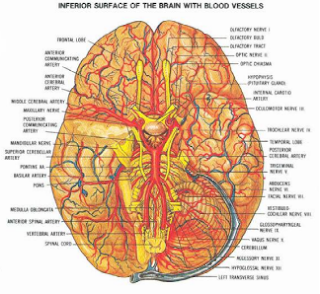Regional blood flow
1. Coronary blood flow
2. Cerebral blood flow
3. Renal blood flow
4. Splanchnic blood flow
5. Cutaneous blood flow
6. Skeletal muscle blood flow
Blood flow is not distributed equally to all organs and tissues and depends on the control of relative vascular resistance between organs.
In some organs, there is considerable variation in blood flow; this occurs, for example, in the gastrointestinal tract during digestion of a meal or in muscle during exercise.
In other organs, such as the brain and the kidney, blood flow is relatively constant.
1. Coronary blood flow
Unlike blood flow to other organs, blood flow to the myocardium is higher during diastole than during systole. The higher rate of flow to the myocardium occurs because contraction of the myocardium during systole compresses coronary blood vessels, limiting coronary blood flow. Tachycardia may present a problem for coronary perfusion because most blood flow occurs during the diastolic period, which becomes shorter as HR increases.
2. Cerebral blood flow
The brain requires a constant supply of O2, and its blood flow is relatively independent of systemic blood pressure and autonomic nervous system activity.
Cerebral blood flow is mainly determined by several “physiologic” base of regulation: myogenic autoregulation and local metabolic regulation.
By myogenic autoregulation blood flow is relatively constant over a wide range of blood pressure, from approximately 60 mm Hg to 130 mm Hg. Cerebral arterioles respond directly to the degree of distention by varying smooth muscle tone. When blood pressure decreases, there is less wall distention on arterioles; thus, smooth muscle relaxes and increases vessel diameter, which reduces resistance and restores blood flow.
By local metabolic regulation increased neuronal activity and O2 consumption cause local vasodilation.
Blood gases, particularly the arterial CO2 partial pressure, strongly influence cerebral blood flow. For example, dizziness associated with hyperventilation is caused by cerebral vasoconstriction resulting from increased CO2 excretion and reduced partial pressure CO2. Conversely, increased partial pressure CO2 causes cerebral vasodilatation.
Variations in O2 have little effect unless severe hypoxemia (low PaO2) occurs, resulting in pronounced cerebral vasodilatation.
3. Renal blood flow
Among the major organs, the kidneys have one of the highest rates of blood flow (about 2000 L per day), which is necessary to supply enough plasma for glomerular filtration. Despite high O2 consumption rates per gram of kidney tissue, usually renal perfusion far exceeds the needs of local cellular metabolism. As a result, the kidney has the lowest O2 extraction of the major organs.
Unlike cerebral blood flow, blood flow to the kidneys is not controlled by metabolic factors. Renal blood flow is most strongly influenced by autoregulation and sympathetic tone. Under most circumstances, renal blood flow is relatively constant because myogenic autoregulation operates over a blood pressure range of 60 mm Hg to 160 mm Hg.
4. Splanchnic blood flow
1. The splanchnic circulation depends on the eating. Local metabolism increases blood flow after a meal.
2. Another feature of the splanchnic circulation is the portal venous system . It is responsible for directing blood from parts of the gastrointestinal tract to the liver. The system extends from about the lower portion of the esophagus to the upper part of the anal canal. It also includes venous drainage from the spleen and pancreas.
Many drugs that are absorbed through the gastrointestinal tract are substantially metabolized by the liver before reaching general circulation. As a consequence, certain drugs can only be taken via certain routes. For example, nitroglycerin cannot be swallowed because the liver would deactivate the medication, but it can be taken under the tongue or transdermally (through the skin) and thus is absorbed in a way that bypasses the portal venous system.
5. Cutaneous blood flow
Most blood flow to skin is regulated in response to both thermoregulatory signals and general cardiovascular control of systemic blood pressure. Activation of efferent norepinephrinergic sympathetic nerves by such means as pain, cold, fear, or low systemic blood pressure leads to cutaneous vasoconstriction, directing blood to more vital organs. On the other hand, increased core body temperature causes sweating and cutaneous vasodilatation to increase heat loss.
6. Skeletal muscle blood flow
Skeletal muscle has a large flow reserve compared to that of resting blood flow. At rest, there is relatively high vascular tone and a high proportion of capillaries are not perfused. Blood flow to resting muscle is strongly influenced by norepinephrinergic sympathetic vasoconstriction. During dynamic exercise, more than 75% of cardiac output may be directed to working skeletal muscle, blood flow is increased more than in 3 times.



